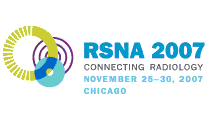
Abstract Archives of the RSNA, 2007
SSG19-02
Comparison of Full Chest CTA with Limited CTA and Triple Rule-out CTA for PE Detection and Effective Dose Implications
Scientific Papers
Presented on November 27, 2007
Presented as part of SSG19: ISP: Cardiac (CT)
 Trainee Research Prize - Resident
Trainee Research Prize - Resident
Hetal Patel MD, Presenter: Nothing to Disclose
Bret Francis Coughlin MD, Abstract Co-Author: Nothing to Disclose
Terry LaFrance MS, Abstract Co-Author: Nothing to Disclose
Gail O'Donnell-Moran RT, Abstract Co-Author: Nothing to Disclose
Determine if application of a limited field CTA used for "Triple Rule Out"(TRO-CTA) would limit detection of PE. Effective dose of CTA using standard and limited scan protocols was assessed.
Retrospective IRB approved review of 600 CTA for PE(CTPA). Presence and location of PE, distances above the top of the aortic arch, and below the heart was recorded. TRO CTA would include arch to the bottom of the heart.
The dose to lung and heart was determined by using Al2O3 Dots in the Rando and Standard Imaging IMRT phantoms utilizing a CTPA protocol using long (330mm) and short (186mm) field on a 64 detector CT with beam modulation. Radiation dose with Cardiac protocol (CCTA) on the 64 detector row CT with 0.75mm collimation and prospective EKG gating was measured.
The effective doses were compared for full chest CTPA, limited chest CTPA, and TRO CTA using CCTA parameters.
600 CTPA studies included. 50(8.3%) studies demonstrated PE, all would have been diagnosed between the top of arch and the undersurface of the heart. 534(89%) of the studies were negative for PE and 16 (2.7%) were suboptimal examinations for assessment of small PE. PE were primarily in the lower lobes.
The average effective dose of a full chest CTPA 5.4 mSv, abrreviated CTPA 2.8 mSV, TRO CTA 10.6 mSv. The effective radiation dose of a limited field CTPA would be reduced by 48% relative to full chest CTPA. There is a 96% increase in dose for TRO CTA relative to full chest CTPA. There is a 286% increase in effective radiation dose if a full chest CTPA is performed using CCTA parameters compared to full chest CTPA.
Limited field TRO CTA would not limit accuracy in diagnosis of PE. The radiation dose varies depending upon the length of the scan and the parameters used. There is an increase in radiation dose using CCTA vs CTPA parameters. Limiting scan coverage to the area between the arch and bottom of the heart would decrease dose of CTPA.
A TRO CTA protocol for evaluation of PE, aortic dissection, and coronary disease would not limit diagnosis of PE, but would result in a higher effective radiation dose.
Patel, H,
Coughlin, B,
LaFrance, T,
O'Donnell-Moran, G,
Comparison of Full Chest CTA with Limited CTA and Triple Rule-out CTA for PE Detection and Effective Dose Implications. Radiological Society of North America 2007 Scientific Assembly and Annual Meeting, November 25 - November 30, 2007 ,Chicago IL.
http://archive.rsna.org/2007/5010948.html


 Trainee Research Prize - Resident
Trainee Research Prize - Resident